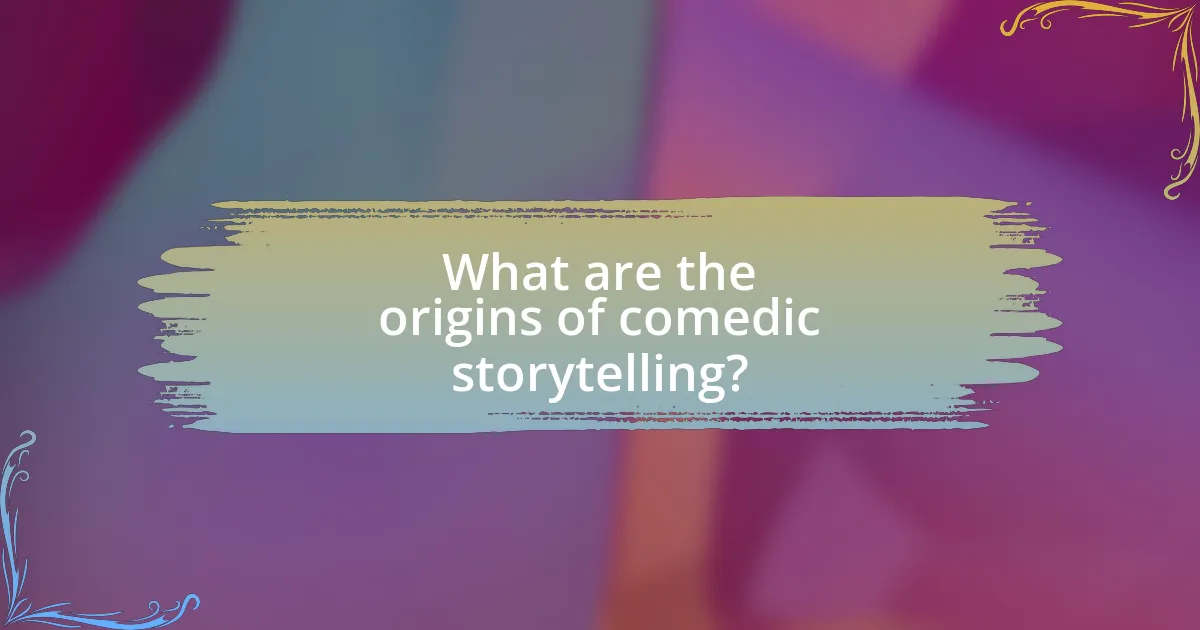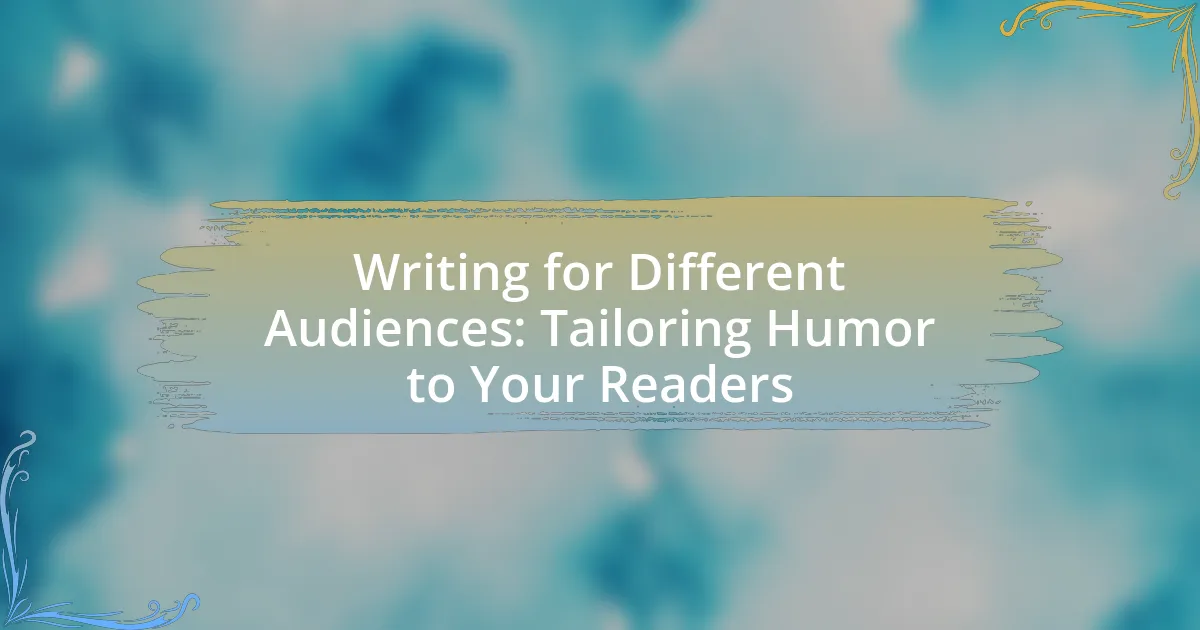The article examines the evolution of comedic storytelling from ancient times to the present, highlighting its transformation through various historical periods and cultural contexts. It traces the origins of comedy in ancient Greece and Rome, the influence of the Middle Ages, and the innovations of the Renaissance and Enlightenment. The discussion includes the impact of modern media, such as film and television, on comedic narratives, as well as the role of diverse voices and contemporary trends in shaping humor today. Key themes include the relationship between comedy and societal values, the techniques used in modern storytelling, and the significance of humor in addressing social issues.

What is the Evolution of Comedic Storytelling?
The evolution of comedic storytelling spans from ancient oral traditions to contemporary digital platforms. Initially, comedic storytelling emerged in ancient civilizations, such as Greece, where playwrights like Aristophanes used satire to critique society and politics. This form of comedy laid the groundwork for later developments, including the Roman comedic traditions that incorporated farce and slapstick elements.
During the Middle Ages, comedic storytelling evolved through the use of jesters and troubadours, who entertained audiences with humor interwoven into narratives. The Renaissance period saw the rise of commedia dell’arte, characterized by improvised performances and stock characters, which influenced modern theatrical comedy.
In the 19th century, comedic storytelling transitioned to vaudeville and burlesque, emphasizing variety acts and situational humor. The advent of film in the early 20th century introduced silent film comedies, with figures like Charlie Chaplin and Buster Keaton pioneering visual humor.
The late 20th century and early 21st century witnessed the rise of stand-up comedy and sitcoms, with comedians like Richard Pryor and shows like “Friends” shaping comedic narratives in television. Today, comedic storytelling continues to evolve through digital media, including social media platforms and streaming services, allowing for diverse voices and styles to reach global audiences.
This historical progression illustrates how comedic storytelling has adapted to cultural shifts and technological advancements, maintaining its relevance and impact across generations.
How has comedic storytelling changed over time?
Comedic storytelling has evolved significantly from ancient times to the present, reflecting changes in societal norms, technology, and audience expectations. In ancient Greece, for instance, comedic plays often featured satirical elements that critiqued politics and society, as seen in the works of Aristophanes, who used humor to address serious issues. During the Middle Ages, comedic storytelling shifted towards farce and slapstick, often performed in public spaces, which catered to a less literate audience. The advent of the printing press in the 15th century allowed for the wider distribution of comedic literature, leading to the rise of humor in written forms, such as essays and novels.
In the 20th century, the introduction of film and television transformed comedic storytelling by incorporating visual elements and timing, exemplified by comedians like Charlie Chaplin and later, sitcoms that blended humor with relatable narratives. The internet and social media in the 21st century have further revolutionized comedic storytelling, enabling rapid dissemination of jokes and memes, allowing for real-time audience interaction and feedback. This shift has led to a more diverse range of comedic voices and styles, reflecting a globalized culture. Overall, comedic storytelling has transitioned from structured performances in theaters to a dynamic, multifaceted medium that adapts to contemporary societal contexts.
What are the key historical milestones in comedic storytelling?
Key historical milestones in comedic storytelling include the origins of comedy in ancient Greece, particularly with playwrights like Aristophanes in the 5th century BCE, who introduced satirical elements in theater. The Roman era saw the adaptation of Greek comedic forms, with figures like Plautus and Terence shaping comedic narratives. The Middle Ages featured the rise of commedia dell’arte in Italy, emphasizing improvisation and stock characters. The 18th century brought about the emergence of the modern novel, with authors like Jonathan Swift using satire to critique society. The 20th century introduced film and television as new mediums for comedy, with influential figures such as Charlie Chaplin and later sitcoms like “I Love Lucy” redefining comedic storytelling. Each of these milestones reflects significant shifts in cultural context and audience engagement in the art of comedy.
How did cultural shifts influence comedic narratives?
Cultural shifts significantly influenced comedic narratives by altering societal norms, values, and humor perceptions. For instance, the transition from feudal societies to more egalitarian structures in the Renaissance allowed for satire to flourish, as seen in the works of playwrights like Molière, who critiqued social hierarchies. Additionally, the rise of mass media in the 20th century transformed comedy, with television shows like “Saturday Night Live” reflecting contemporary issues and diverse perspectives, thus broadening comedic narratives to include various cultural viewpoints. These examples illustrate how changes in culture directly shaped the themes, styles, and audiences of comedic storytelling throughout history.
Why is comedic storytelling important in society?
Comedic storytelling is important in society because it serves as a tool for social commentary and cultural reflection. Through humor, comedians can address sensitive topics, challenge societal norms, and provoke thought, making complex issues more accessible. For instance, studies have shown that humor can facilitate discussions about race, politics, and mental health, allowing audiences to engage with these subjects in a less confrontational manner. Additionally, comedic storytelling fosters community and connection, as shared laughter can strengthen social bonds and promote empathy among diverse groups.
What role does humor play in human communication?
Humor plays a crucial role in human communication by facilitating social bonding and enhancing interpersonal relationships. It serves as a tool for expressing emotions, diffusing tension, and promoting group cohesion. Research indicates that laughter and humor can trigger the release of endorphins, which foster feelings of happiness and connection among individuals. For instance, a study published in the journal “Psychological Science” by Robert Provine found that laughter is often a social phenomenon, occurring more frequently in group settings than in solitary situations, highlighting its importance in social interactions.
How does comedic storytelling reflect societal values and issues?
Comedic storytelling reflects societal values and issues by using humor to critique and highlight cultural norms, beliefs, and conflicts. For instance, satire, a prominent form of comedic storytelling, has historically addressed political corruption and social injustices, as seen in works like Jonathan Swift’s “A Modest Proposal,” which critiques British policy towards Ireland. This form of storytelling allows audiences to confront uncomfortable truths in a palatable manner, fostering dialogue about societal problems. Additionally, contemporary comedians often tackle issues such as race, gender, and inequality, exemplified by shows like “The Daily Show,” which uses humor to comment on current events and societal attitudes, thereby influencing public perception and discourse.

What are the origins of comedic storytelling?
The origins of comedic storytelling can be traced back to ancient civilizations, particularly in Greece and Rome, where humor was an integral part of theatrical performances. Greek playwrights like Aristophanes utilized satire and parody in their works, addressing social and political issues through comedic narratives. Similarly, Roman playwrights such as Plautus and Terence adapted Greek comedic forms, emphasizing character-driven humor and situational comedy. These early forms of comedic storytelling laid the groundwork for later developments in humor, influencing various cultures and theatrical traditions throughout history.
How did ancient civilizations contribute to comedic storytelling?
Ancient civilizations significantly contributed to comedic storytelling through the development of theatrical forms and literary works that incorporated humor. For instance, the Greeks introduced comedy as a distinct genre in theater, exemplified by playwrights like Aristophanes, whose works satirized contemporary society and politics, blending humor with social commentary. Similarly, the Romans adapted Greek comedic traditions, with playwrights such as Plautus and Terence creating comedic plays that emphasized mistaken identities and humorous situations, influencing later comedic narratives. These early comedic forms established foundational techniques, such as irony, exaggeration, and character archetypes, which continue to shape comedic storytelling today.
What forms of comedic storytelling existed in ancient Greece and Rome?
Ancient Greece and Rome featured several forms of comedic storytelling, primarily including Greek Old Comedy, Greek New Comedy, Roman Comedy, and Satire. Greek Old Comedy, exemplified by playwrights like Aristophanes, utilized exaggerated characters and political satire to critique contemporary society. Greek New Comedy, represented by Menander, focused on everyday life and romantic entanglements, emphasizing character-driven plots. Roman Comedy, influenced by Greek traditions, included playwrights such as Plautus and Terence, who adapted Greek works and introduced elements of farce and stock characters. Additionally, Satire, notably practiced by Roman poets like Juvenal and Horace, employed humor to critique social norms and moral issues. These forms collectively shaped the comedic landscape of their respective cultures, influencing later comedic traditions.
How did folklore and oral traditions shape early comedic narratives?
Folklore and oral traditions significantly shaped early comedic narratives by providing a rich repository of cultural stories, characters, and humor that reflected societal values and norms. These narratives often featured archetypal figures, such as tricksters and fools, who embodied humor and wit, allowing audiences to engage with complex themes in an accessible manner. For instance, the use of satire in folklore allowed for social commentary, enabling storytellers to critique authority and societal issues while entertaining their audience. This interplay between humor and cultural critique is evident in various traditions, such as the European jesters and the African griots, who utilized comedic elements to convey moral lessons and communal values. Thus, the integration of folklore and oral traditions into comedic narratives established foundational storytelling techniques that continue to influence modern comedy.
What influences shaped comedic storytelling in the Middle Ages?
Comedic storytelling in the Middle Ages was shaped primarily by social, religious, and cultural influences. The rise of the Church significantly impacted comedic narratives, as religious themes often intertwined with humor, leading to the creation of morality plays that used comedy to convey moral lessons. Additionally, the feudal system and the dynamics of class relations provided fertile ground for satire, as jesters and minstrels used humor to critique the nobility and reflect the lives of common people. The influence of classical texts, particularly those from ancient Rome and Greece, also played a crucial role, as medieval writers adapted and reinterpreted these works, infusing them with contemporary humor and societal commentary. Historical records indicate that festivals and public performances, such as those during Carnival, further encouraged comedic expression, allowing for a temporary suspension of social norms and the exploration of taboo subjects through laughter.
How did the church and societal norms affect humor during this period?
The church and societal norms significantly restricted humor during this period by enforcing moral standards that dictated acceptable content. Religious authorities often viewed humor as potentially blasphemous or irreverent, leading to censorship of comedic expressions that challenged or mocked religious beliefs. For instance, during the Middle Ages, the church’s influence resulted in a preference for humor that aligned with moral teachings, while satire and parody were often suppressed to maintain social order and religious piety. This suppression is evidenced by the limited acceptance of comedic works that critiqued the church or societal hierarchies, as seen in the writings of figures like Geoffrey Chaucer, whose humor often skirted the boundaries of ecclesiastical approval.
What were the popular comedic forms in medieval literature?
Popular comedic forms in medieval literature included fabliaux, morality plays, and jest books. Fabliaux were short, humorous tales often featuring clever tricksters and satirical commentary on social norms, exemplified by works like “The Miller’s Tale” from Geoffrey Chaucer’s “The Canterbury Tales.” Morality plays, such as “Everyman,” used allegory to convey moral lessons with comedic elements, blending humor with serious themes. Jests and anecdotes compiled in jest books provided a collection of humorous stories and jokes, reflecting the comedic tastes of the time. These forms collectively illustrate the diverse approaches to humor in medieval literature, engaging audiences through wit and satire.

How did the Renaissance and Enlightenment periods impact comedic storytelling?
The Renaissance and Enlightenment periods significantly transformed comedic storytelling by introducing a focus on humanism and reason, which emphasized individual experience and social critique. During the Renaissance, playwrights like Shakespeare incorporated complex characters and situational humor, moving away from the simplistic comedic forms of earlier periods. The Enlightenment further advanced this by promoting satire as a tool for social commentary, exemplified by writers such as Molière and Voltaire, who used humor to challenge societal norms and expose hypocrisy. This evolution in comedic storytelling reflected broader cultural shifts towards valuing intellect and personal agency, making comedy a vehicle for both entertainment and philosophical exploration.
What new styles emerged during the Renaissance?
During the Renaissance, new styles such as humanism, realism, and classical revival emerged. Humanism emphasized the value of human beings and the study of classical texts, leading to a focus on individual experience and emotion in art and literature. Realism sought to depict subjects as they are, capturing everyday life and the human condition with accuracy. The classical revival involved a return to the aesthetics and themes of ancient Greek and Roman works, influencing architecture, literature, and visual arts. These styles collectively transformed storytelling and artistic expression, reflecting the complexities of human nature and society during this period.
How did playwrights like Shakespeare innovate comedic storytelling?
Playwrights like Shakespeare innovated comedic storytelling by integrating complex characters, intricate plots, and a blend of high and low humor. Shakespeare’s use of mistaken identities, such as in “Twelfth Night,” created comedic situations that explored themes of love and social status. Additionally, his incorporation of wordplay and puns, exemplified in “A Midsummer Night’s Dream,” showcased linguistic creativity that engaged audiences. Shakespeare also broke the fourth wall, allowing characters to address the audience directly, which added a layer of intimacy and humor. These techniques not only entertained but also provided social commentary, making his comedies relevant and impactful.
What role did satire play in Enlightenment comedic works?
Satire served as a critical tool in Enlightenment comedic works by exposing societal flaws and encouraging reform through humor. Prominent figures such as Voltaire and Jonathan Swift utilized satire to critique political corruption, religious hypocrisy, and social injustices, effectively engaging audiences in discussions about morality and governance. For instance, Swift’s “A Modest Proposal” employed biting irony to highlight the dire conditions of the Irish poor, prompting readers to reflect on the inhumane treatment they faced. This use of satire not only entertained but also fostered a climate of intellectual discourse, making it a vital component of Enlightenment literature.
How did the advent of modern media transform comedic storytelling?
The advent of modern media transformed comedic storytelling by enabling diverse formats and broader audience reach. Television, film, and digital platforms allowed comedians to experiment with timing, visual gags, and narrative structures, enhancing the comedic experience. For instance, the rise of sitcoms in the 1950s introduced a new episodic format that combined humor with character development, exemplified by shows like “I Love Lucy.” Additionally, the internet has facilitated the rapid dissemination of comedic content, allowing viral videos and memes to reach millions instantly, as seen with platforms like YouTube and TikTok. This shift has democratized comedy, allowing voices from various backgrounds to contribute to the genre, thus enriching comedic storytelling.
What impact did film and television have on comedic narratives?
Film and television significantly transformed comedic narratives by introducing new storytelling techniques and broadening audience reach. The visual medium allowed for the incorporation of timing, physical comedy, and visual gags, which enhanced comedic delivery compared to traditional forms like theater. For instance, the advent of sitcoms in the mid-20th century, such as “I Love Lucy,” utilized a multi-camera setup that captured live audience reactions, creating a feedback loop that shaped comedic timing and structure. Additionally, the rise of streaming platforms has led to diverse comedic styles, allowing niche narratives to flourish, as seen in shows like “BoJack Horseman,” which blends humor with deeper emotional themes. This evolution illustrates how film and television have not only expanded the scope of comedic narratives but also influenced their complexity and accessibility.
How has the internet changed the landscape of comedic storytelling?
The internet has transformed comedic storytelling by democratizing content creation and distribution, allowing diverse voices to reach global audiences. Platforms like YouTube, TikTok, and social media enable comedians to share their work without traditional gatekeepers, leading to a surge in varied comedic styles and formats. For instance, the rise of meme culture has introduced a new, rapid-fire method of humor that often relies on visual elements and cultural references, appealing to younger audiences. Additionally, data from a 2021 Pew Research study indicates that 69% of U.S. adults use social media, highlighting the vast potential reach for comedic content. This shift has not only expanded the types of humor available but also changed audience engagement, as viewers can interact directly with creators through comments and shares, fostering a more participatory comedic landscape.

What are the contemporary trends in comedic storytelling?
Contemporary trends in comedic storytelling include the rise of diverse voices, the blending of genres, and the use of digital platforms for distribution. Diverse voices have become prominent, with comedians from various backgrounds sharing unique perspectives, as seen in shows like “Master of None” and “Insecure.” The blending of genres is evident in works that combine comedy with drama, such as “The Good Place,” which explores philosophical themes while maintaining humor. Additionally, digital platforms like Netflix and social media have transformed how comedic content is created and consumed, allowing for shorter formats and immediate audience feedback, exemplified by viral sketches on platforms like TikTok. These trends reflect a shift towards inclusivity, innovation, and adaptability in comedic storytelling.
How do modern comedians address social issues through humor?
Modern comedians address social issues through humor by using satire, observational comedy, and personal anecdotes to highlight societal flaws and provoke thought. For instance, comedians like John Oliver and Hasan Minhaj tackle topics such as immigration and healthcare, using humor to make complex issues more relatable and accessible. Their performances often include factual data and real-life examples, which reinforce their messages and encourage audiences to engage with these critical topics. This approach not only entertains but also fosters dialogue and awareness around pressing social issues, demonstrating the power of comedy as a tool for social commentary.
What are the common themes in today’s comedic storytelling?
Common themes in today’s comedic storytelling include social commentary, absurdity, and personal experiences. Social commentary often addresses contemporary issues such as politics, race, and gender, reflecting societal norms and challenges. Absurdity plays a significant role, utilizing surreal situations and illogical scenarios to evoke laughter, as seen in shows like “The Office” and “Rick and Morty.” Personal experiences are frequently shared, allowing comedians to connect with audiences through relatable anecdotes, exemplified by stand-up routines from artists like Ali Wong and Kevin Hart. These themes resonate with audiences, making comedic storytelling relevant and impactful in modern culture.
How do diverse voices contribute to the evolution of comedy?
Diverse voices significantly contribute to the evolution of comedy by introducing varied perspectives, cultural nuances, and unique storytelling techniques. This inclusion enriches comedic narratives, allowing for a broader range of humor that resonates with diverse audiences. For instance, the rise of stand-up comedians from different backgrounds, such as Dave Chappelle and Ali Wong, has brought attention to social issues through humor, reflecting the complexities of race, gender, and identity. Research indicates that comedy rooted in diverse experiences fosters empathy and understanding, as seen in studies by the University of California, which highlight how humor can bridge cultural divides. Thus, the integration of diverse voices not only enhances comedic content but also drives societal conversations, making comedy a dynamic and evolving art form.
What techniques are used in modern comedic storytelling?
Modern comedic storytelling employs techniques such as observational humor, satire, and absurdism. Observational humor focuses on everyday situations and relatable experiences, allowing audiences to connect with the material. Satire critiques societal norms and politics, often using exaggeration to highlight flaws, as seen in shows like “Saturday Night Live.” Absurdism introduces illogical scenarios and nonsensical elements, creating humor through surprise and unpredictability, exemplified in works like “The Office.” These techniques reflect the evolution of comedy, adapting to contemporary cultural contexts and audience expectations.
How do timing and delivery enhance comedic effect?
Timing and delivery significantly enhance comedic effect by controlling the rhythm and pace of jokes, which influences audience reactions. Effective timing allows comedians to create suspense before a punchline, maximizing surprise and laughter; for instance, a well-timed pause can heighten anticipation, making the eventual joke more impactful. Delivery, including vocal inflection and physical gestures, adds layers to the humor, as seen in stand-up performances where comedians use body language to emphasize their points. Research indicates that timing and delivery are crucial elements in humor appreciation, as they can alter the perceived funniness of a joke by up to 50%.
What role does improvisation play in contemporary comedy?
Improvisation plays a crucial role in contemporary comedy by enhancing spontaneity and audience engagement. It allows comedians to react in real-time to their environment, audience reactions, and current events, creating a dynamic performance that feels fresh and relevant. This technique is evident in formats like stand-up, sketch comedy, and improvisational theater, where performers often rely on quick thinking and adaptability. For instance, shows like “Whose Line Is It Anyway?” exemplify how improvisation can lead to unexpected humor and memorable moments, showcasing the skill of comedians to craft jokes on the spot. This reliance on improvisation not only fosters creativity but also strengthens the connection between the performer and the audience, making the comedic experience more interactive and enjoyable.
What can we learn from the evolution of comedic storytelling?
The evolution of comedic storytelling teaches us that humor reflects societal values and cultural shifts over time. For instance, ancient Greek comedies often addressed political themes and social norms, showcasing how humor can critique authority and provoke thought. In contrast, modern comedic storytelling frequently incorporates diverse perspectives and addresses contemporary issues, indicating a shift towards inclusivity and social awareness. This progression illustrates that as societies evolve, so too does the nature of humor, adapting to the changing landscape of human experience and communication.
How can understanding comedic history improve modern storytelling?
Understanding comedic history enhances modern storytelling by providing insights into the structures, themes, and techniques that have resonated with audiences over time. Historical comedic forms, such as Greek theater and commedia dell’arte, reveal foundational elements like timing, character archetypes, and situational irony that remain effective today. For instance, the use of slapstick in early comedy has influenced contemporary physical humor, demonstrating that certain comedic devices have enduring appeal. By studying these historical contexts, modern storytellers can craft narratives that are not only innovative but also rooted in proven comedic traditions, thereby increasing their effectiveness and audience engagement.
What best practices can be applied to create effective comedic narratives?
To create effective comedic narratives, writers should focus on strong character development, timing, and relatable situations. Strong character development allows audiences to connect with the characters, making their comedic experiences more impactful. Timing is crucial in comedy; well-placed punchlines and pauses enhance humor. Relatable situations resonate with audiences, as shared experiences often elicit laughter. Research indicates that humor is most effective when it reflects common human experiences, as seen in studies by the University of California, which found that relatable humor increases audience engagement and enjoyment.





